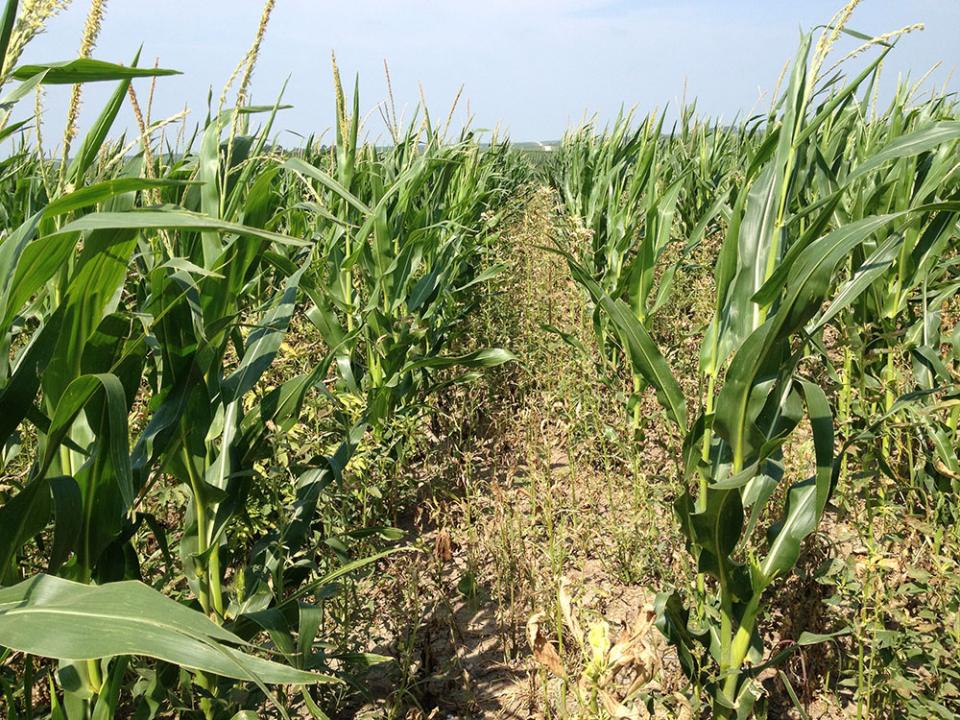
Weed Management Considerations Following Hail Damage to Corn or Soybean
Mid-season weed control relies on a dense crop canopy to prevent or suppress weed growth, even after herbicides may no longer be active. Hail can severely delay or damage crop canopy development, and under these conditions a late weed emergence can occur in canopy gaps. If left unmanaged, this flush of weeds could result in yield loss, harvest issues, and an increased weed seed bank the following year. An important question arises when hail damage occurs mid-season, especially as crops canopy: “What are effective weed control options?” In answering, a number of factors should be considered.
Herbicides and the Fine Print
- Crop Growth Stage. Many herbicide applications are limited by the growth stage of the crop at time of application. The Nebraska Extension Guide for Weed, Disease, and Insect Management in Nebraska (EC130) provides helpful information about crop growth limits (pages 174-175). In addition, these Nebraska Extension publications provide information about determining the growth stage for corn (EC126) and soybean (EC128).
- Replant Options and Rotation Restrictions: Previously applied herbicides for the now-hailed crop will dictate replant options (EC130 pages 176-189). For example, if Fierce (flumioxazin + pyroxasulfone) was applied preemergence in soybean, soybean could be replanted at any time. However, it would not be possible to rotate to grain sorghum due to the 18-month rotation restriction for grain sorghum following Fierce.
- Grazing Restrictions: Planting forage cover crops after hail could be a viable option, as long as those cover crop do not violate rotation restrictions set by previously applied herbicides, as well as the grazing restrictions for any herbicides applied after the forage cover crop is planted. For example, if Verdict (saflufenacil + dimethenamid-P) was applied in corn, a forage cover crop of oats and red clover could not be planted for grazing until the next cropping season. In addition, since the Verdict was applied to corn, the corn residue following hail could not be grazed until 80 days after application. (See grazing restrictions, EC130 pages 190-193.)
- Additional Herbicide Applications: To manage late-emerging weeds brought on by hail damage additional herbicide applications may be effective. When making applications, it is important to follow herbicide label guidelines as products will have single and annual application rate restrictions. As an example, if Authority Maxx was applied for preemergence weed control in soybean at the high label rate of 7.5 fl oz/acre, it could not be applied a second time after hail as the label will only allow one full rate per year. The pre-harvest interval is another consideration when making additional late-season herbicide applications following hail, since many herbicides restrict application leading up to harvest to limit potential carry-over in the grain (EC130, pages 174-175).
Herbicides to Consider Using
The herbicides that follow have no growth stage restrictions, relatively short pre-harvest intervals, and would allow rotation to either corn or beans the following season, making them good options for late-season application following hail damage:
Soybean (Herbicide Site of Action):
- Select Max, Poast (Group 1)
- Classic, Scepter, Harmony SG (Group 2)
- Cobra, Phoenix, Ultra Blazer, Resource (Group 14)
- Warrant- can be applied up to R2 (Group 15)
Corn (Herbicide Site of Action)
- 2,4-D-pre-tassle if directed application (Group 4)
- Basagran, Buctril-can be applied pre-tassel (Group 6)
- Impact (Group 27)
As a reminder, always follow current label recommendations and restrictions when applying herbicides.
Reference
2018 Guide For Weed, Disease, and Insect Management in NebraskaOnline Master of Science in Agronomy
With a focus on industry applications and research, the online program is designed with maximum flexibility for today's working professionals.
